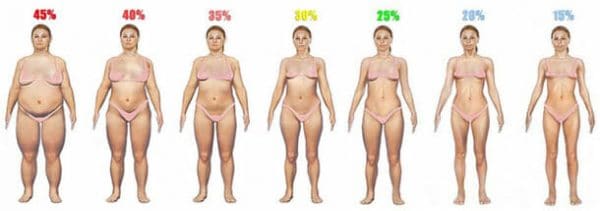Most people are familiar with the term “body fat,” usually associating it with obesity, heart disease, cholesterol levels and general unhealthiness. Despite negative implications when too much fat is carried on your body, some fat is required by the body for proper functioning, metabolic purposes and general health. The key to good health is in finding your right balance between a healthy percentage of carried fat and an unhealthy percentage.
When food is consumed, your body produces its own fat through absorption of the food’s fatty content. In breaking down these consumed fats, your body generates glycerol and fatty acids. Those two fat byproducts are then released into the body for its own use.
Glycerol is processed in your liver, becoming glucose stored as an energy reserve. Fatty acids produced from consumed foods provide energy for cardiac muscles, skeletal muscles and all major tissues. Obviously, without enough glycerol and fatty acids in your body, you will not function well.
Other uses of fats in the body include:
- Maintenance of healthy skin, nails and hair
- Body temperature maintenance
- Energy reserves
- Smooth cellular functioning
- Cushioning of organs and tissues
- Bone shock absorption
- Absorption of vitamins which require fats for processing, such as A, E, D and K
- Protection of the body from ailments
- Healthy reproductive system maintenance in women
How Much is Too Much Fat on Your Body?
Despite requiring fat for healthy functioning, having too much physically-carried fat can negatively impact your body. Stored fats are excess amounts not used or burned off by your body. When such surplus accumulates, obesity may result. Being obese causes a wide spectrum of health problems like arthritis, heart disease, type 2 diabetes, stroke, some cancers and respiratory problems.
In order to remain in healthy balance and prevent obesity-associated health problems, it is important to be aware of your own physical fat percentage and how it measures up against ideals established by the scientific community. Knowing fat percentage also helps determine ideal weight as a goal for healthy weight loss. The best benefit of losing excess fat is that by doing so, your body returns to good health and many obesity-associated health problems disappear.
There are a multitude of ways to measure fat on your individual physical frame. Some of the most popular methods are easy calculations using standard fat calculators developed by branches of the military, the YMCA and a combination of military forms with YMCA. The most popular body fat calculator tools are:
- US Army Calculator
- US Marine Corps Calculator
- US Navy Calculator
- YMCA Fat Algorithm Tool
- Body Fat Calculator using all military and YMCA methods together
Healthy Fat Percentages According to Gender
Medical science has acknowledged that healthy fat percentages differ between men and women. Women carry more fat than men, in most instances. Ovulation and other processes specific to the female gender require additional fat stored within the body.
Men generally carry less fat than women, while still remaining in good health:
- 2 to 5% fat for basic function
- 6 to 13% fat for athletes
- 14 to 17% fat for healthy fitness
- 18 to 24% fat for acceptable wellness
- 25% or higher is considered obese

For women, the following percentages apply:
- 10 to 13% for basic function
- 14 to 20% for athletes
- 21 to 24% for fitness
- 25 to 31% for acceptable wellness
- 32% or more is obese

Fat Percentage and Your Reproductive Health
For a woman desiring to become pregnant, it is important to understand the correlation between fat percentages on the body, ovulation, a healthy pregnancy and other reproductive concerns. Studies have indicated that 12 percent of fertility problems in women are due to low fat percentage on the body. This starts with the sex hormones, which are fat soluble and stored in the body’s fat. Low fat in the body can also result in reduced estrogen, hindering menstruation.
For women trying to reduce the percentage of fat on their body, exercise can also cause problems with fertility. While many women are able to exercise hours per day, every day of the week, other females and their fertility are negatively affected by this level of exercise.
Endorphins produced by the body after working out provide a great “runner’s high.” But they also increase levels of prolactin. Prolactin is released for breast milk production and a high level of this hormone can decrease the potential for pregnancy.
To determine if your push to reduce fat percentage on your body is also lowering your chances of becoming pregnant, you should consider the following signs:
- Menstruation becomes irregular
- Decreased immunity
- Loss of apetite
- Slow heart rate recovery
- Excessive muscle fatigue
- High blood pressure
- Gastrointestinal disturbances
- Unexplainable weight loss
- Depression
- Mood changes
- Poor concentration
- Lethargy
- Sleep disturbance
- Aggression
- Lower self-confidence
- Restlessness
Any of these signs or a combination of multiple issues should be addressed by a physician. By using an ovulation calculator, ovulation can also be tracked by women who seek to become pregnant. This calculator can better target the right days for optimum chance of conception.
Because fat plays an important role in the body’s healthy processes, working too hard to reduce body fat can have serious reproductive health ramifications.
Another Means of Calculating Your Fat: BMI
For many years, experts have used body mass index (BMI) calculations for measurement of health risks associated with weight. More recently, body measurements using the tools such as the military and YMCA calculators have become popular. But what is the difference between these two methods and which is really best as a measure of health?
According to some experts, both fat calculators and BMI measurements have a place in determination of an individual’s state of health. A body mass index calculator is an easy tool using only height, weight and gender to determine BMI.
Many experts use BMI for determination of how weight is affecting an individual’s health and well-being. Both present health status and risk for disease are often determined through use of body mass index, as they have been for many years. BMI can indicate an individual’s risk of developing obesity-related diseases such as heart disease, stroke and diabetes.
The Centers for Disease Control developed a chart of healthy BMI ranges for both male and female adults. Those are:
- 18.5% or less – Underweight
- 18.6 to 24.9% – Recommended healthy weight
- 25 to 29.9% – Overweight
- 30% or more – Obese
Many experts believe BMI is best used in conjunction with fat percentage calculations. This is because BMI offers benefits in learning about an individual’s risk of disease, something that was less derived from fat percentage calculations until recent years.
But many health and fitness professionals see BMI numbers as flawed, being too general to prove entirely useful in determination of health status. Among those professionals is Tammy Callahan of Life Measurement Inc., a professional-grade fat analyzer manufacturer. Tammy said, “These numbers were developed using data from enormous numbers of people. They don’t tell you anything about your own body composition, how much of your weight is fat, and how much is muscles and tissue.”
Body Fat Percentage Knowledge Has Increased
Research on fat percentage has improved in recent years, providing greater information from use of percentage calculations. Now, fat percentages can indicate your overall health as well as or even better than BMI.
A study conducted by Steven Heymsfield, MD of the Obesity Research Center at New York’s St. Luke’s Roosevelt Hospital indicated body-fat percentage is a higher quality gauge of health condition than BMI. Dr. Heymsfield and his colleagues studied more than 1600 men and women of ethnically diverse backgrounds. The subjects’ body measurements were studied to determine the calculations’ quality in determining disease risk. The American Journal of Clinical Nutrition published results in September 2000.
Heyms field noted that BMI does not distinguish fat from muscles and this is where the flaw in use of BMI exists. As Heyms field pointed out, “There are people, especially some highly trained athletes, who are overweight but not overfat. Likewise, there are people who are of a normal weight according to BMI scales but who are overfat. BMI is a broad, general measure of risk. Body-fat assessment is much more specific to your actual fat content and thus provides a more accurate picture.”
How Do You Lose Excess Fat?
Loss of fat from your body’s reserves and weight loss are different concepts, altogether. Muscle tissue is much more dense than fat tissue, if you put a pile of muscle next to the same weight of a pile of fat, the muscle pile will be 20% SMALLER!! So working out will increase your muscles, and decrease your fat, which decreases your size, but you might still weigh the same, or even a little more. This is where the phrase “looking lean” comes from, as you reduce body fat you get that firmer more cut look, but again, this has nothing to do with what you weigh.
An average person who weighs the same as an athletic person with better muscle tone will obviously suffer more fat-related health problems. This is why it is important to focus upon losing fat, rather than losing mere pounds. Using a fat percentage calculator, it is possible to gain a better image of how much fat needs to be lost, so your healthy muscle is not sacrificed.
To focus upon losing fat and not muscle, use a weight loss plan combining a quality exercise regimen with a well-balanced diet of vegetables, fruits, whole grains and as few processed carbohydrates as possible. When fat is lost and your muscle remains, the ideal balance of fat percentage in your body will provide greater overall wellness.
Measuring Your Health Through Fat Percentage
By monitoring your fat percentage using a calculator tool and ensuring healthy physical fitness, it is quite possible to keep many health problems at bay. Staying within a healthy fat range according to gender, measurements, weight or other parameters employed by the calculator tool decreases your risk for obesity related diseases. Some of those diseases include heart disease, type 2 diabetes, hypertension, arthritis and respiratory illnesses.
Because losing excess fat brings your risk of those diseases down, it is never too late to improve your health. Regardless of physical fitness or amount of fat carried on your body’s frame, keeping an eye on percentage of your body’s fat is a sure way to keep your health in check.







